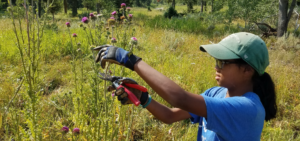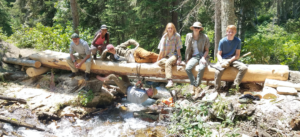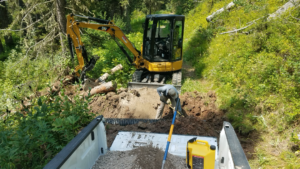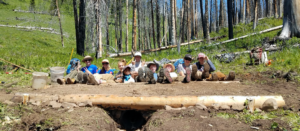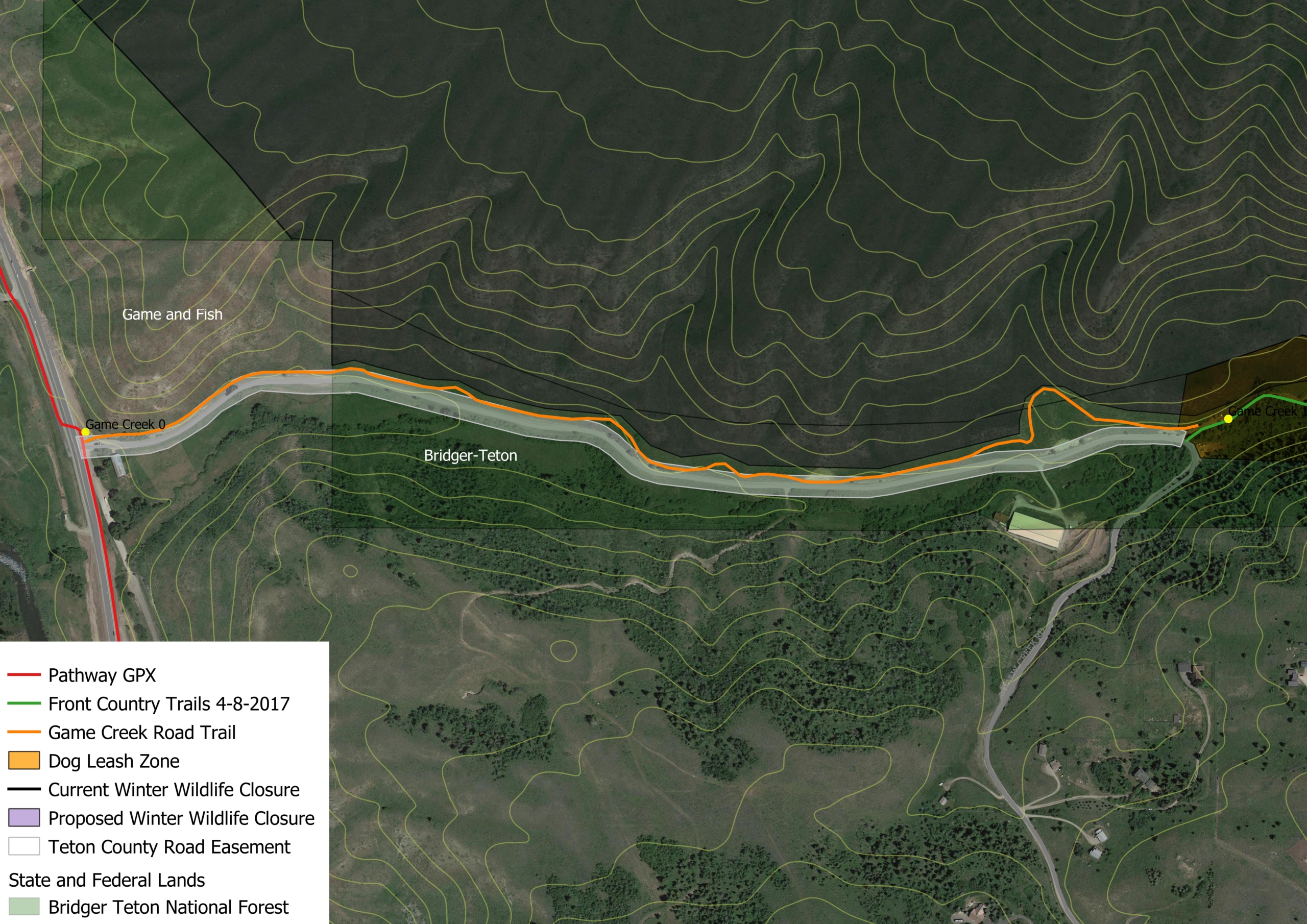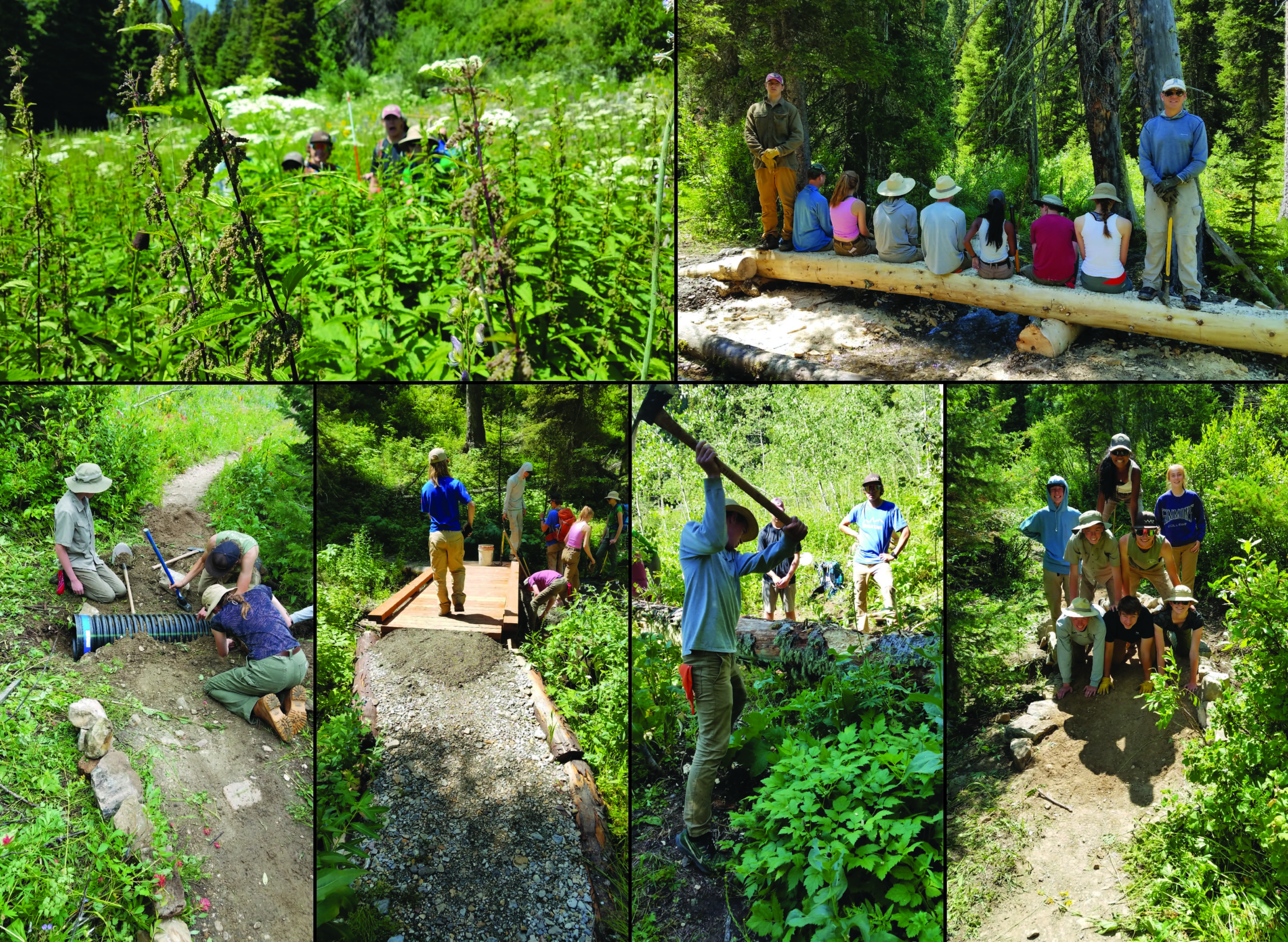Fall is in the air and that means Election Day is coming up. We want you to get out and exercise your right to vote! Before you make that important decision, we thought you might want to know the candidates’ positions on pathways and making walking and biking a preferred mode of travel in Jackson.
Kudos to all the candidates for stepping up to be leaders in our community!
MAYORAL CANDIDATES
HAILEY MORTON LEVINSON
Do you use our local pathways system and/or cycling lanes? If so, for what purposes?
Of course! I use our pathways system for commuting and recreation. I commute daily on my bike and so use the cycling lanes/ shared lanes everyday.
Friends of Pathways is working to ensure a future where every neighborhood is connected to a pathway. Do you support that goal and support the use of public funds to achieve it?
I do support this goal. Having young kids, I recognize how important it is for safe access and use of our pathways. Additionally, as a one car household, I see how critical this access is to encourage our community to use alternative transportation.
How do you feel about the Integrated Transportation Plan and its level of representation for human-powered transportation? How should walking and biking be incorporated into future transportation goals?
Current updates to the Integrated Transportation Plan and Comprehensive Plan better emphasize and call out human-powered transportation and that’s a step in the right direction. I support ways to make walking/ biking/ alternative modes of transportation more of the norm than single occupancy vehicles.
Do you support the development of additional separated biking lanes and multi-use pathways, and if so, where would you prioritize that new infrastructure?
We have made significant strides in adding pathways throughout the valley. I am interested to see Friends of Pathways most recent survey results of where we could do better connecting in town and making that network easier for people to navigate. Protected lanes like what I have supported on Snow King Avenue are great additions to get our community comfortable in using bikes as their preferred choice of transportation.
MICHAEL KUDAR
Do you use our local pathways system and/or cycling lanes? If so, for what purposes?
In our household, we share two commuter bikes and one e-bike. Our teens primarily use the local pathway system to and from High School Road and to visit friends in Wilson.
Friends of Pathways is working to ensure a future where every neighborhood is connected to a pathway. Do you support that goal and support the use of public funds to achieve it?
Pathway connectivity is our most responsible, independent long term solution to combat the negative impacts on our environment. With more locals looking for different ways to commute, I will look to support cycling infrastructure with the safest routes wherever possible.
How do you feel about the Integrated Transportation Plan and its level of representation for human-powered transportation? How should walking and biking be incorporated into future transportation goals?
As your mayor, I will support initiatives, incentives, sound policy, and software technologies for smarter walking and cycling options alongside public transport, making it easier for people to move around Jackson. I would like to create incentives to future developments who build walking and cycling infrastructure for direct connectivity to trails, green alleyways, pathways, multi-use lanes, and transit routes/hubs.
Do you support the development of additional separated biking lanes and multi-use pathways, and if so, where would you prioritize that new infrastructure?
Yes. We know the community is long overdue for real solutions to ease traffic congestion and reduce wildlife collisions. In town, taking long term planning advice from Friends of Pathways and START Bus and Bike Transport, and our citizens, I will support pathway designs that vastly improve safe routes to and from schools, as well as connections making it easier for residents to access retail, grocery, and small business.
TOWN COUNCIL CANDIDATES
DEVON VIEHMAN
Do you use our local pathways system and/or cycling lanes? If so, for what purposes?
Yes, my family and I love using the bike paths. They make me feel safer than biking directly on the road.
Friends of Pathways is working to ensure a future where every neighborhood is connected to a pathway. Do you support that goal and support the use of public funds to achieve it?
Yes, I support this goal. Our pathways system contributes to less traffic, less greenhouse gas emissions, and adds to Jackson’s dynamic character.
How do you feel about the Integrated Transportation Plan and its level of representation for human-powered transportation? How should walking and biking be incorporated into future transportation goals?
When the town and county plan new neighborhoods, walkability/bikeability is imperative. Thanks to a grant I secured with the National Association of Realtors last year, I was able to host a free seminar on Smart Growth Principles. Two of the Smart Growth Principles are “Create walkable neighborhoods” and “Provide a variety of transportation choices.” I will use these principles to guide my decision-making regarding neighborhood development, along with the new national policy to create “Complete Streets,” and I will encourage my fellow Councilors to learn about and implement these principles as well.
Do you support the development of additional separated biking lanes and multi-use pathways, and if so, where would you prioritize that new infrastructure?
Safety is one of the main reasons I use the bike paths, and creating separated biking lanes would increase safety and usage. I know that students and parents of students attending Munger Mountain Elementary are eager for the bike paths to connect south of town so that the school is accessible by bike, and I can’t wait to see that project finished. The prioritization of new infrastructure will be dependent on the health of our Town Budget, particularly in light of the strain that COVID-19 has put on our resources.
JESSICA SELL CHAMBERS
Do you use our local pathways system and/or cycling lanes? If so, for what purposes?
Yes, my family and I use our bike pathways and cycle lanes multiple times a day. We take them everywhere we go because we mainly take our bikes and e-bikes everywhere we go. This summer every weekday I used the pathways from town to go out to the Science Schools for my son’s summer camp. When I worked out in the Aspens I would bike out and back every day as well. We love our pathways! We ride from the moment it is warm enough until the moment the snow sticks. We avoid our car (singular) as often as we can, especially with the worsening traffic.
Friends of Pathways is working to ensure a future where every neighborhood is connected to a pathway. Do you support that goal and support the use of public funds to achieve it?
Absolutely, I support connecting as many places as possible via a pathway. We need to get people out of their cars as much as possible for so many reasons. In non-pandemic times, I support using public funds for the public good, such as pathways. *All of these projects take a backseat though until we get our bearings with COVID-19. We have yet to figure out what this next year will bring – and we also need to pass the 7th cent sales tax! But pathways and mass/public transportation, in general, are major priorities for me.
How do you feel about the Integrated Transportation Plan and its level of representation for human-powered transportation? How should walking and biking be incorporated into future transportation goals?
Given the effects of climate change and the Town’s commitment to being carbon neutral, we absolutely must increase human-powered transportation. Part of getting people out of their cars is making alternative modes of transportation more appealing and accessible, which is done through a robust walking and biking system. The ITP is great for so many reasons and it really layouts a thorough path forward, no pun intended. Expanding the ITP breadth a touch more in the direction of human-powered means of transportation is just one more step, no pun intended again, toward getting people out of their cars and us to carbon neutral.
Do you support the development of additional separated biking lanes and multi-use pathways, and if so, where would you prioritize that new infrastructure?
Having separated biking lanes is great; it’s safer, faster, and less congested. I would ask that we make sure all neighborhoods are connected to some kind of pathway network to begin and then adding additional lanes in town to make biking on the streets safer and more conducive to biking. We love the bike lanes down Snow King Ave and across town past Miller Park. These kinds of bike routing are a good direction to move in. (Transportation puns abound!)
JIM ROOKS
Do you use our local pathways system and/or cycling lanes? If so, for what purposes?
My family and I use the Pathways daily,….at least during Spring, Summer and Fall! We live on Flat Creek Drive and can coast downhill to connect with the Snow King Ave Pathway, and thus the entire network of extraordinary “Human Lanes” that connect our Town and County. We use the Pathways for both recreation and utility. Between my wife and 2 kids, we have a dozen different bikes in our corral. Our favorite family trip is South through town down Russ Garaman Park past the schools, past 3 Creek and around South Park back home. I am recovering from catastrophic injuries due to being hit by a motor vehicle while mountain biking last summer, so my wife and I’s “fast laps” on the road bikes up to Jenny Lake and back haven’t happened much lately! But, we all increasingly use the Pathways to get to work, school, athletic practices, and community events, which is the best “pro move” in Jackson. I call it the only “shortcut” left in Jackson Hole!
Friends of Pathways is working to ensure a future where every neighborhood is connected to a pathway. Do you support that goal and support the use of public funds to achieve it?
Connectivity is critical. I both support and applaud this endeavor to make sure we all have access to our Pathways. Pathways represent the best of the “common good” and thus requires government support. There will be no greater champion of Friends of Pathways than me. And I say that knowing most candidates and elected officials support Pathways. Pathways enriches and saves the lives of our citizens and visitors. I will work to maintain and expand funding, both to care for our current Pathways, as well as expanded funding for improved connectivity. The Pathways also “give back” economically and environmentally to society, making them an excellent investment in every sense of the word.
How do you feel about the Integrated Transportation Plan and its level of representation for human-powered transportation? How should walking and biking be incorporated into future transportation goals?
Section 3 of the ITP, “Active Transportation,” details that “neither the Town of Jackson nor the neighborhoods and villages in rural Teton County have extensive, safe accommodation for local bicycling on local roads and streets.” “Walkability” is also a weakness within the current system. The data suggests that “short trips” to the “first and last mile” are a perfect place to invest resources. And, of course, parking and winter maintenance on in-town Pathways remain areas of improvement. That said, I would like to see expanded emphasis on human powered transportation, both in the ITP and Comprehensive Plan, including massive active transportation options in Northern South Park.
Do you support the development of additional separated biking lanes and multi-use pathways, and if so, where would you prioritize that new infrastructure?
After my accident, I am extremely “gun shy” to send my 11 year old son and his friends racing across town to flag football practice, but the Pathways provide! The separated bike lanes are the primary reason why I feel safe having my kids bike. They are also extremely beneficial to daily bike commuters. I think the best additional bike and multi-purpose lanes are in direct connection to existing ones, namely Snow King Avenue and Maple Way. The Snow King lane could be extended East to either Willow or Vine, then further East to Redmond Avenue and beyond. The downtown area also begs for new and expanded human-only pathways.
PETE MULDOON
Do you use our local pathways system and/or cycling lanes? If so, for what purposes?
I use both pathways and cycling lanes, primarily for transportation. I’m an e-bike user, and have replaced my car with the e-bike whenever feasible.
Friends of Pathways is working to ensure a future where every neighborhood is connected to a pathway. Do you support that goal and support the use of public funds to achieve it?
I support that goal 110%. We have to stop subsidizing and prioritizing SOVs, and I believe residents are demanding better alternatives.
How do you feel about the Integrated Transportation Plan and its level of representation for human-powered transportation? How should walking and biking be incorporated into future transportation goals?
I believe a large percentage of our residents are willing and able to ride bikes and walk. We’ve got a responsibility to create the infrastructure to allow them to do that. If we do, we can reduce reliance on vehicles, help families move from two cars to one or from one to none, and reduce not only VMT and the associated impacts, but reduce the need to dedicate land to parking rather than housing. I believe the ITP needs to go much further, particularly by envisioning a radically different alternative to our current land use and transportation paradigm.
Do you support the development of additional separated biking lanes and multi-use pathways, and if so, where would you prioritize that new infrastructure?
I do. I would like to start by extending the SK bike lane to the Snow King Hotel and to the Rec Center/school complex, as well as to the hospital. We also need more east/west connectivity. We will need to better manage residential parking in order to do that, which I have consistently advocated for.
COUNTY COMMISSION CANDIDATES
GREG EPSTEIN
Do you use our local pathways system and/or cycling lanes? If so, for what purposes?
Yes, for exercise, recreation and commuting.
Friends of Pathways is working to ensure a future where every neighborhood is connected to a pathway. Do you support that goal and support the use of public funds to achieve it?
Yes, I see a future Jackson Hole where there are safe options regarding how you travel around this valley. My voting record has been pro pathways and I will continue to support pathway connectivity.
How do you feel about the Integrated Transportation Plan and its level of representation for human-powered transportation? How should walking and biking be incorporated into future transportation goals?
Overall I support the ITP despite the reality that we are falling behind in its recommendations and milestones. One place that I do think we are keeping up with is pathways. While we could always do more, with the new pathways on South 89 added to the system we are slowly connecting more of the community. I really think we need to look at the system as it stands now and identify where hazards exist and address those. Whether it’s an underpass on 390 to the Milward Addition, speed control around Garaman Park or more education on safe pathway use, safety needs to be a priority.
Do you support the development of additional separated biking lanes and multi-use pathways, and if so, where would you prioritize that new infrastructure?
I could be open to multilane pathways, but I would like to see more information on where the most necessary locations should be. We probably need an updated pathways masterplan pinpointing where these lanes should exist. Additionally, we would need to sell the community on why additional pathway lanes might be necessary since public funds will be required. In my opinion I could see multi-lanes on 390 and in town extending one mile north and south of the Jackson boundary.
NATALIA MACKER
Do you use our local pathways system and/or cycling lanes? If so, for what purposes?
Yes! My family uses them for biking, and I use them for running. They’ve also been a great help for walking meetings outdoors to stay as safe as possible.
Friends of Pathways is working to ensure a future where every neighborhood is connected to a pathway. Do you support that goal and support the use of public funds to achieve it?
Yes. I think there is tremendous opportunity to advance equity through this type of connectivity. While different projects will have different funding combinations, I will continue to support public funds for pathways.
How do you feel about the Integrated Transportation Plan and its level of representation for human-powered transportation? How should walking and biking be incorporated into future transportation goals?
The ITP is a place to start and needs improvement. Moving forward, I am particularly interested in how we can leverage and reimagine the pathways taskforce to be a driving force in incorporating human-powered transportation within the ITP but also in relation to our health, equity, climate, and housing goals.
Do you support the development of additional separated biking lanes and multi-use pathways, and if so, where would you prioritize that new infrastructure?
Yes, the ones the immediately come to mind are completing South Highway 89 to Hoback and the ongoing effort to ensure pathways along the Highway 22 corridor.
PETER LONG
Do you use our local pathways system and/or cycling lanes? If so, for what purposes?
Like many Teton County residents, my family and I regularly use the pathways system for recreation and commuting. Working with small businesses throughout the valley, I frequently use our pathways to bike to and from meetings. My wife and I have a two-year old son, Walter. All the time we use our pathways to get him out for a walk or bike ride, and to access local trails.
Friends of Pathways is working to ensure a future where every neighborhood is connected to a pathway. Do you support that goal and support the use of public funds to achieve it?
I fully support expanding our pathways system to connect neighborhoods throughout the valley. Doing so will help reduce traffic on our roads, reduce emissions and protect our wildlife. Everyone should be able to access our pathways system conveniently from where they live. As your Commissioner, I look forward to working with Friends of Pathways to continue to grow and improve our pathways system.
How do you feel about the Integrated Transportation Plan and its level of representation for human-powered transportation? How should walking and biking be incorporated into future transportation goals?
The Integrated Transportation Plan is a good guiding document to reduce vehicle traffic and support our transition to alternative forms of transit. It deserves credit for seeking to make our neighborhoods more accessible to bikers and pedestrians, including its call for greater pathways funding, and for considering “first and last mile” access to public transit (i.e., making START routes easier to get to on foot or by bike).
That said, the ITP would benefit from greater specificity. There is a noticeable lack of guidance about how the plan intends to increase human-powered transportation, especially relative to other modes, like public transit.
Practical considerations – like a schedule that prioritizes new pathways and bike lanes, clear assignment of authority, recommendations for bike shares and programs that will improve usage, “rules of the road” for pathways, and clearer partnerships with our non-profits and private sector – will better ensure the ITP fosters human-powered transportation and reduces vehicle traffic.
Finally, the ITP is toothless unless it is implemented with fidelity. WYDOT’s recommendation against dedicated HOV / bus lanes on Highway 22 and 390, which conflicts with the ITP, demonstrates the importance of building relationships in every direction to ensure the ITP is implemented in a way that achieves its goals and changes behaviors.
Do you support the development of additional separated biking lanes and multi-use pathways, and if so, where would you prioritize that new infrastructure?
I fully support continued development of our pathways and bike lanes. These resources connect our community, provide access to recreation and alternative forms of commuting, and will help alleviate traffic on our roads.
It’s important that new development be considered as part of a comprehensive transportation picture so that we are building synergy between public transit, carpooling opportunities and pedestrian traffic. That means putting in pathways that connect neighborhoods with public transit nodes and extending the pathways system to incorporate outlying areas, like Hoback. We should consider bike lanes along primary arteries in residential areas, like Rafter J, to better plug in with existing pathways.
At the same time, we should be considering ways to increase usage of our pathways and bike lanes—like incentive programs for biking to work, clearly communicated “rules of the road” to make pathways and bake lanes safer, and programs that will foster a bike and pedestrian culture.
As Commissioner, I pledge to work with Friends of Pathways and likeminded organizations to continue to build on our outstanding pathways system and to make our roads and alternative forms of transportation safer and more effective.
WES GARDNER
Do you use our local pathways system and/or cycling lanes? If so, for what purposes?
Yes, occasionally. Although I’m not much of a biker, I do enjoy using the pathways to jog and walk. As a Game Creek resident, it’s great to know that we have access so far down south.
Friends of Pathways is working to ensure a future where every neighborhood is connected to a pathway. Do you support that goal and support the use of public funds to achieve it?
Absolutely! I live in Game Creek, and it’s so great that we have pathways connected to a neighborhood so far from town. I love that our pathways not only range so far from town, but they are also so interconnected, so that riders can get almost anywhere in the valley using them.
How do you feel about the Integrated Transportation Plan and its level of representation for human-powered transportation? How should walking and biking be incorporated into future transportation goals?
Two summers ago, I spearheaded and ran a program aimed at getting downtown employers to reward employees for certain methods of getting to and from work. Biking/walking earned the most rewards, with carpooling and riding the bus a close second, and parking in the parking garage representing a third tier (it was built as an incentive program to get employees to stop parking in the three hour zone). While this program did achieve some success, I believe that we can do much better. START is now offering an employer-funded, annual Universal Pass which will give riders year round access to the entire system at no charge. I envision a system whereby motivated employers can track their employee’s behaviors and reward those who walk, bike, carpool, or ride the bus to work. I have been working on this for a couple of years and am proud of the role that I played as a START board member to create the Universal Pass.
Do you support the development of additional separated biking lanes and multi-use pathways, and if so, where would you prioritize that new infrastructure?
I do support the development of additional connectivity of our bike lanes and pathways. I am particularly interested in creating meaningful connections through town, so that pedestrians and bikers feel safe as they travel through town. Further, I am very interested in the completion of the bike path loop running from Teton Village to Moose.
CHRISTIAN BECKWITH
Do you use our local pathways system and/or cycling lanes? If so, for what purposes?
Yes, for everything—commuting, grocery shopping, kiddo shuttles, the works. The pathway system has allowed us to make our e-bikes our car replacement strategy.
Friends of Pathways is working to ensure a future where every neighborhood is connected to a pathway. Do you support that goal and support the use of public funds to achieve it?
Yes. At the 2014 SHIFT Summit, I worked with The Jackson Hole Conservation Alliance and the (then) Jackson Hole Community Pathways to bring Chuck Marohn, the President and Co-Founder of Strong Towns, to Jackson to participate in a workshop on effective, efficient transportation systems. The workshop explored the financing and planning of efficient and effective transportation systems with key Jackson Hole stakeholders. Since then, I’ve been a proponent of strategic use of financing to connect all neighborhoods to pathways.
How do you feel about the Integrated Transportation Plan and its level of representation for human-powered transportation? How should walking and biking be incorporated into future transportation goals?
It’s a good start. It can be made better. The 2014 SHIFT Summit convinced me of the opportunity to crowdsource the successes (and failures) of communities like ours to strengthen initiatives like the ITP.
In 2014, we solicited nominations from transportation, conservation, and affordable housing initiatives from GEMS (Gateways to Environments of Major Significance—communities like ours that depend on the environment for the economic and community success) from around North America, and then invited community partners such as the the Jackson Hole Community Pathways, the Teton County Conservation District and the Community Housing Trust to evaluate their work.
The nominees deemed to be the most innovative, impactful and replicable received our Sustainability Awards, and were invited to present their work at the festival. The result was a unique gathering of leaders of GEMS, sharing the practices that were making their communities more sustainable.
Using that year’s SHIFT as a template, we could create RISE (Resilient. Inspired. Sustainable. Everyday), an annual summit that looked at sustainability’s future through the prism of GEMS.
Each year, RISE would choose a topic relevant to GEMS. Let’s use transportation as an example.
We could invite members of transportation organizations like FOP in our community to evaluate the work of transportation initiatives from other GEMS on the basis of impact, innovation and replicability. We could honor the work deemed to be the best with The RISE Awards, and then invite representatives from the winning organizations to share their insights and initiatives here in Teton County at the annual summit.
The summit would thus highlight success stories, explore solutions to shared challenges and create networking opportunities among participants, our own community members included. The networking and sharing of ideas that it fostered would contribute to a stronger ITP and the protection of the “golden goose” of our ecosystem, which should be a priority for all of us, at the same time.
Do you support the development of additional separated biking lanes and multi-use pathways, and if so, where would you prioritize that new infrastructure?
The current biggest impediment to safe biking I’d like to see addressed is crossing the intersection at the Y and continuing toward Smiths. From the intersection on, you’re taking your life in your hands. I’d like to see a separated bike lane or bike path on that section next.













